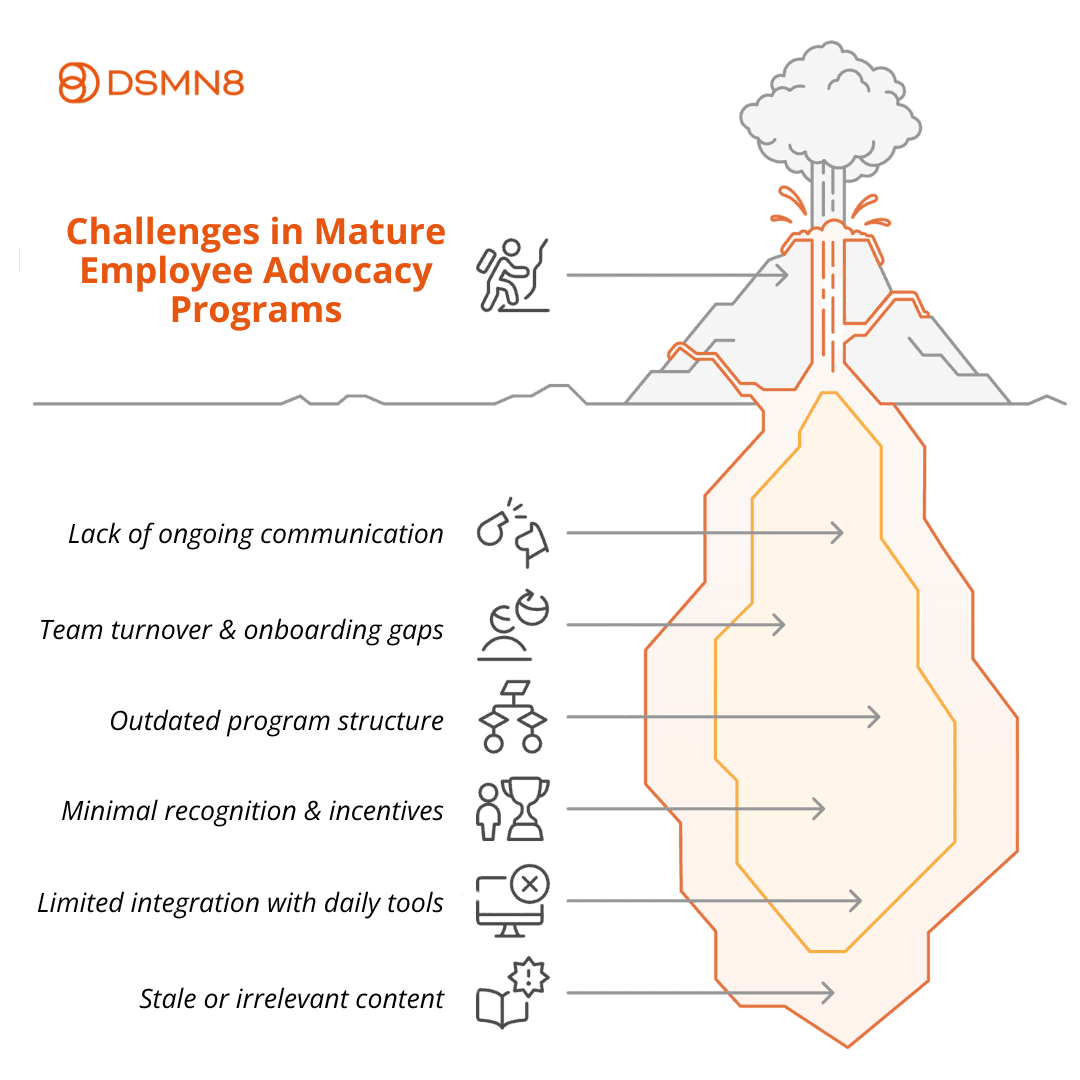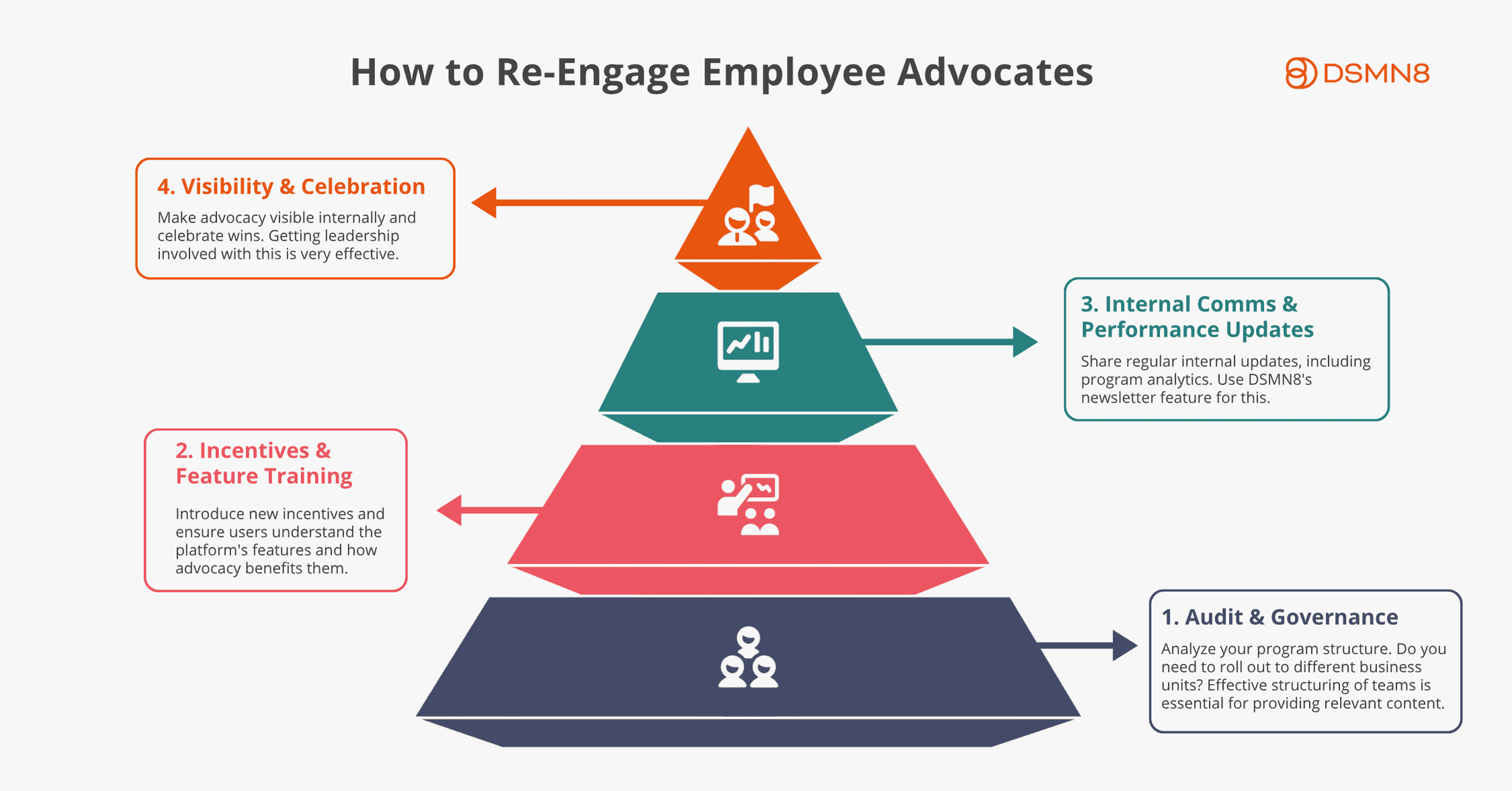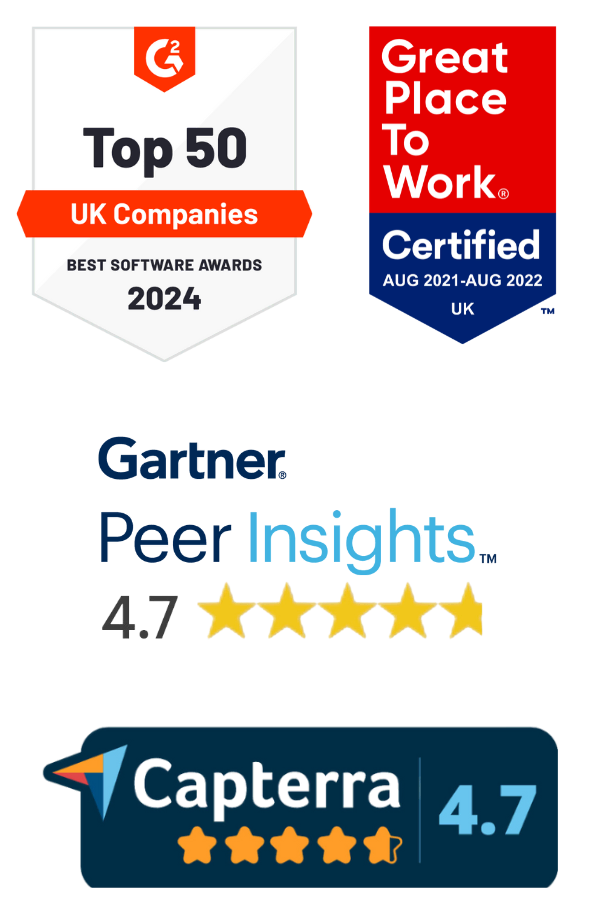
What's on this page:
- Why Do Advocacy Programs Lose Steam?
- Key Hurdles in Mature Employee Advocacy Programs.
- Internal Tactics for Re-Engagement.
- Using DSMN8 to Spark Employee Engagement.
- Client Success Stories: What Works.
- Best Practices: How to Kickstart Your Re-Engagement Strategy.
- Final Thoughts & Additional Resources.
Sustaining engagement in an employee advocacy program can be tough, especially as your initiative matures.
Many program managers find that after the initial launch, participation drops, and it becomes harder to keep employees motivated to share content regularly. If you’re searching for ways to re-engage employees in your advocacy program, you’re not alone!
This guide is packed with practical strategies to boost employee advocacy engagement, including proven internal communications tactics, recognition ideas, and examples from brands that have successfully revived their programs 💪
Whether you need tips for relaunching your advocacy program, motivating employees to participate, or keeping momentum going long-term, you’ll find actionable solutions here to help your advocacy efforts succeed.
Why Do Advocacy Programs Lose Steam?
It’s a familiar story for many program managers: after launching an employee advocacy program, excitement is high and participation is strong. But as months or years go by, activity drops, and it gets harder to motivate employees to keep sharing and engaging.
The reality is, it’s completely normal for engagement to slow down in mature employee advocacy programs. Teams grow and change, internal priorities shift, and what once felt fresh can start to feel routine.
Sometimes, employees simply don’t see the value in participating anymore, especially if they’re not recognized for their efforts or reminded about the impact they make.
But here’s the good news: engagement can be revived 🌱
With the right strategies and a renewed focus on communication, recognition, and improved program structure, you can boost participation and restore the energy that made your advocacy program successful in the first place.
Here at DSMN8, we’ve experienced this first-hand in mature programs. From making content strategy adjustments to increasing volume through managed services, to completely overhauling governance, there is always room for improvement.
I spoke with Emily Jones, Director of Customer Success, and Elliot Elsley, Director of Sales Operations & Engineering at DSMN8, to determine the best ways to revitalize advocacy programs, with a particular focus on long-term clients.
But first, let’s break down the most common hurdles that get in the way of success. Then we’ll explore ways to address them and get your team excited about advocacy again 👇
Key Hurdles in Mature Employee Advocacy Programs
As your employee advocacy program matures, a few familiar challenges can start to affect participation and results.
According to our customer success experts, these are the most common hurdles employee advocacy program managers in mature programs struggle with:
Acknowledging which of these hurdles affect your program is the first step to re-engaging employee advocates.
Let’s take a look at effective tactics for increasing engagement:
Internal Tactics for Re-Engagement
It’s essential to remember that reintroducing employees to your advocacy program isn’t just about sending a few reminders.
Yes, that might spark a few more shares here and there, but taking a more holistic approach to re-engagement can be a real game-changer.
Think of it as building a pyramid, where each level supports the next. Here are four crucial steps to help you rebuild and sustain engagement:
Using DSMN8 to Spark Employee Engagement
Once you’ve identified your biggest challenges, it’s time to use technology to put your re-engagement plan into action.
DSMN8 is designed to foster ongoing employee participation, equipping program managers with everything they need to breathe new life into advocacy and keep it engaging and relevant for staff at every stage.
If you’re not yet using DSMN8, this will give you an idea of how we support continued program engagement. And if you’re already using the platform, perhaps this will spark some fresh ideas or spotlight features you might not know about yet!

Custom Newsletters & Internal Posts
Keep advocacy front and center with customizable newsletters.
These can highlight top-performing shareable content, reveal program analytics insights, include social media tips, and recognize employees for their contributions.
Segmenting newsletters by region, department, or team ensures updates are relevant and personalized, helping to spark renewed interest and ongoing participation. Plus, dynamic email lists mean you won’t need to manually add email addresses when users join the program 👏
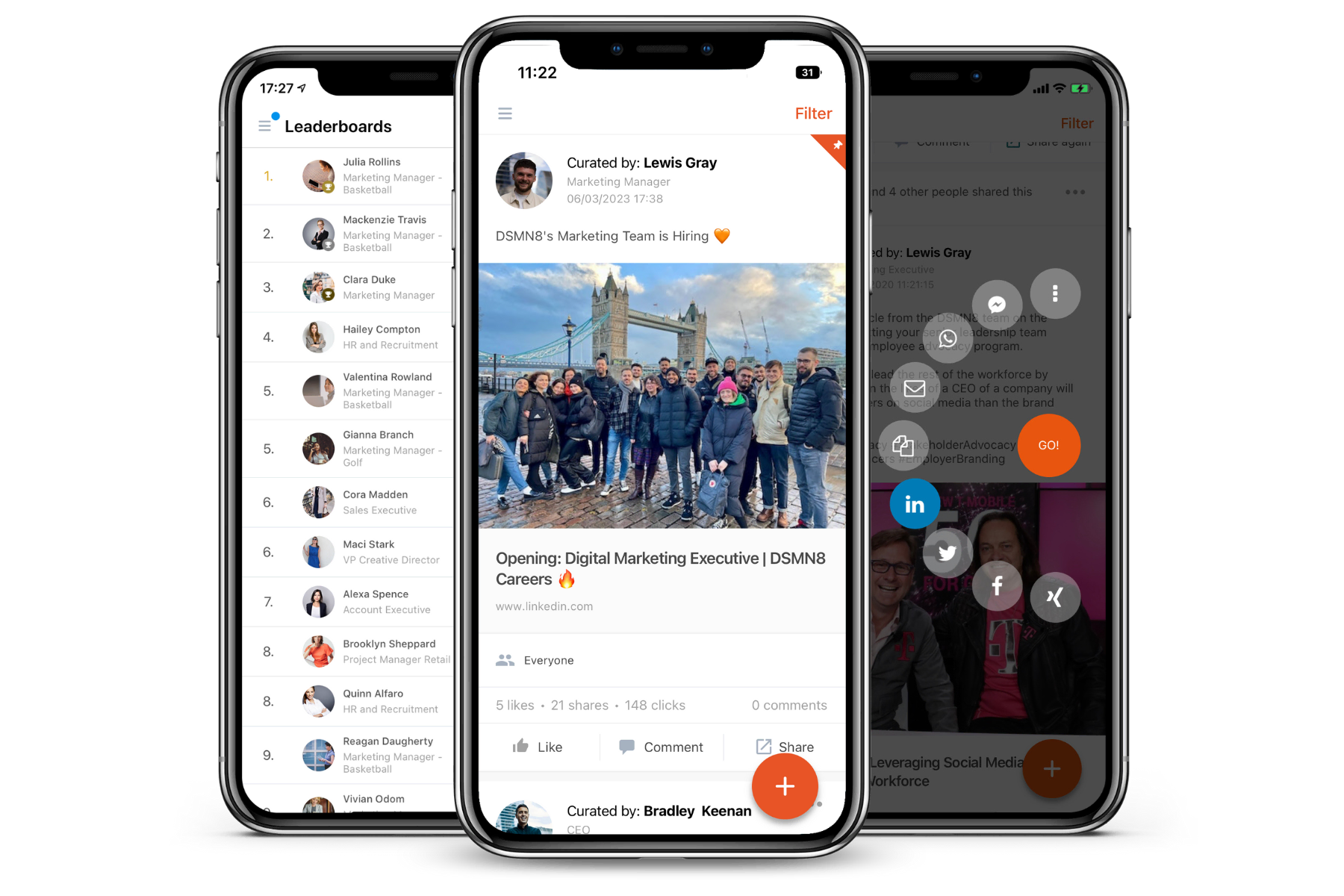
Gamification: Leaderboards & Rewards
Leverage DSMN8’s built-in recognition tools to celebrate top advocates with leaderboards and high fives.
Gamification elements, such as awarding points for sharing content, encourage friendly competition and make advocacy feel more fun. You can also offer leaderboard prizes or points-redeemable rewards if you wish!

Integrations with Everyday Tools
Integrate advocacy seamlessly into daily workflows by connecting the platform with tools employees already use, like Microsoft Teams, Slack, or Salesforce.
In-app notifications, auto-scheduling, and one-click content boosting make it easier than ever for employees to be active on social media, whether they’re desk-based or not.
Onboarding & Training
Regularly highlight platform features and run training sessions for both new joiners and experienced users. Share ‘feature spotlights’ in your newsletters or internal posts can show advocates new ways to get involved, discover underused tools, or take advantage of recent updates.
Including advocacy in your onboarding process ensures every new employee understands how and why to get started.
As Agata Qanadilo, Employer Branding and Recruitment Marketing Manager at Astra Zeneca says:
“Employees are no longer just seen as brand ambassadors or notice boards but as genuine advocates who are empowered to share their unique perspectives and experiences. We are here not to deliver content and encourage them to post. Our role is to educate them, equip them with personal branding knowledge, and let them shine for us.”
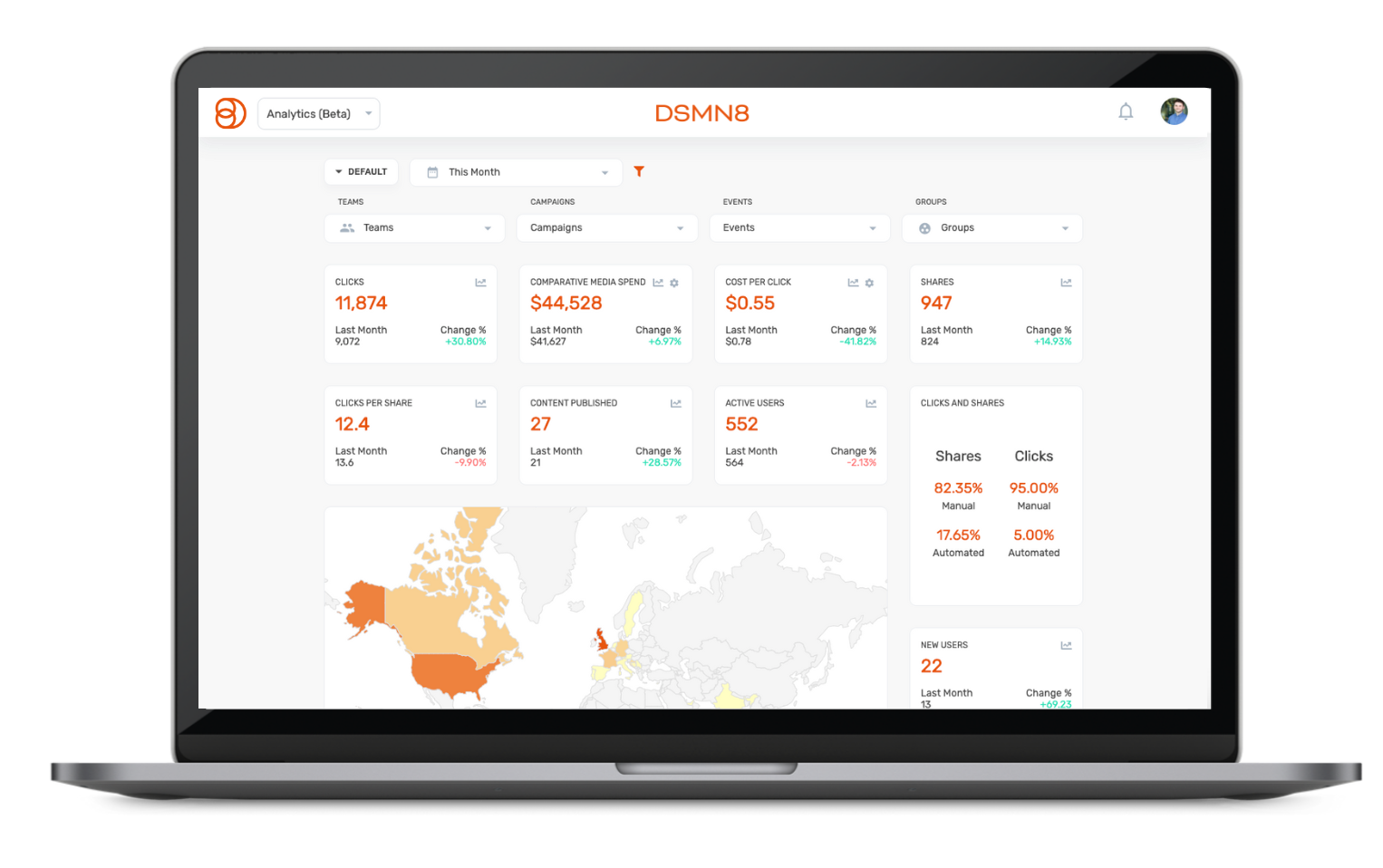
Performance Analytics & Personal Impact
Give employees clear visibility into their personal impact. Easy-to-read dashboards display shares, clicks, and reach, helping advocates see the direct results of their efforts. When employees understand the influence they have, they’re more likely to stay engaged and motivated.
Client Success Stories: What Works.
Here’s the part I was most excited to uncover:
How have long-term DSMN8 clients embarked on a re-engagement campaign, and most importantly, what was the most successful approach to take?
I knew that Dropbox’s program had a very successful launch, spearheaded by the brilliant Katherine, who made a guest appearance on our podcast.
And I’d seen the impact employee advocacy can have from our case studies (AkzoNobel’s $100,000 in earned media value springs to mind!).
But what happens years later? 🤔
Emily and Elliot brought these strategies to life with real success stories. At one tech company, monthly social media workshops didn’t just boost everyday participation, they helped transform an executive into a LinkedIn Top Voice 🏆
In another case, a program in the pharmaceutical sector gained new momentum after redesigning its platform structure. This made it easy to roll out advocacy across multiple business units, with tailored content for each segment.
These examples will show you what’s possible when you pair the right tools with a little creativity and leadership buy-in.
Nissan: Creating 'Micro-Programs' for Different Business Units & Regions for Ultimate Personalization
Nissan took their employee advocacy program to the next level by developing tailored ‘micro-programs’ for different business units and regions.
Instead of relying on a single, one-size-fits-all approach, they mapped out the unique needs and cultures of each group, delivering localized content and communication tailored to their specific requirements.
This level of personalization helped drive participation, made employees feel more connected to the program, and resulted in engagement surging from 500 to over 2,000 users across the organization 🤯
Be sure to watch program leader Brad Nevin’s interview on the Employee Advocacy & Influence Podcast for more expert guidance:
Pharmaceutical Sector: Restructuring Program & Leveraging Managed Services for Increased Output
When engagement stalled after several years, one pharmaceutical client partnered with DSMN8’s managed services for six months to relaunch and rebuild momentum.
The team launched a recruitment drive to add new users, introduced gamification to make the program more rewarding, and rolled out the program to four new regions by creating tailored micro-programs.
To drive ongoing engagement, they regularly shared internal posts featuring social media tips, sent out newsletters featuring top content and program analytics, and gave shoutouts to employees with the most shares and engagement 🎉
They also spotlighted platform features like personal posts, helping users discover new ways to get involved with the program. By taking a comprehensive approach, they revived a stagnant program and created an active, engaged advocacy community.
PMI: Building Internal Awareness Through IRL Events
This one is an excellent example of making advocacy part of your company culture.
PMI took their program recruitment efforts offline and into the workplace by leveraging in-person events to introduce the program.
To make joining easy, they placed QR codes on office posters and digital screens, allowing employees to quickly access the platform and get involved on the spot. This hands-on approach significantly increased internal awareness and sparked new interest across teams that weren’t previously involved.
Impressively, PMI developed a brand identity around the platform, calling it ‘Inside Out’, and even created merch to share with employees at internal events.
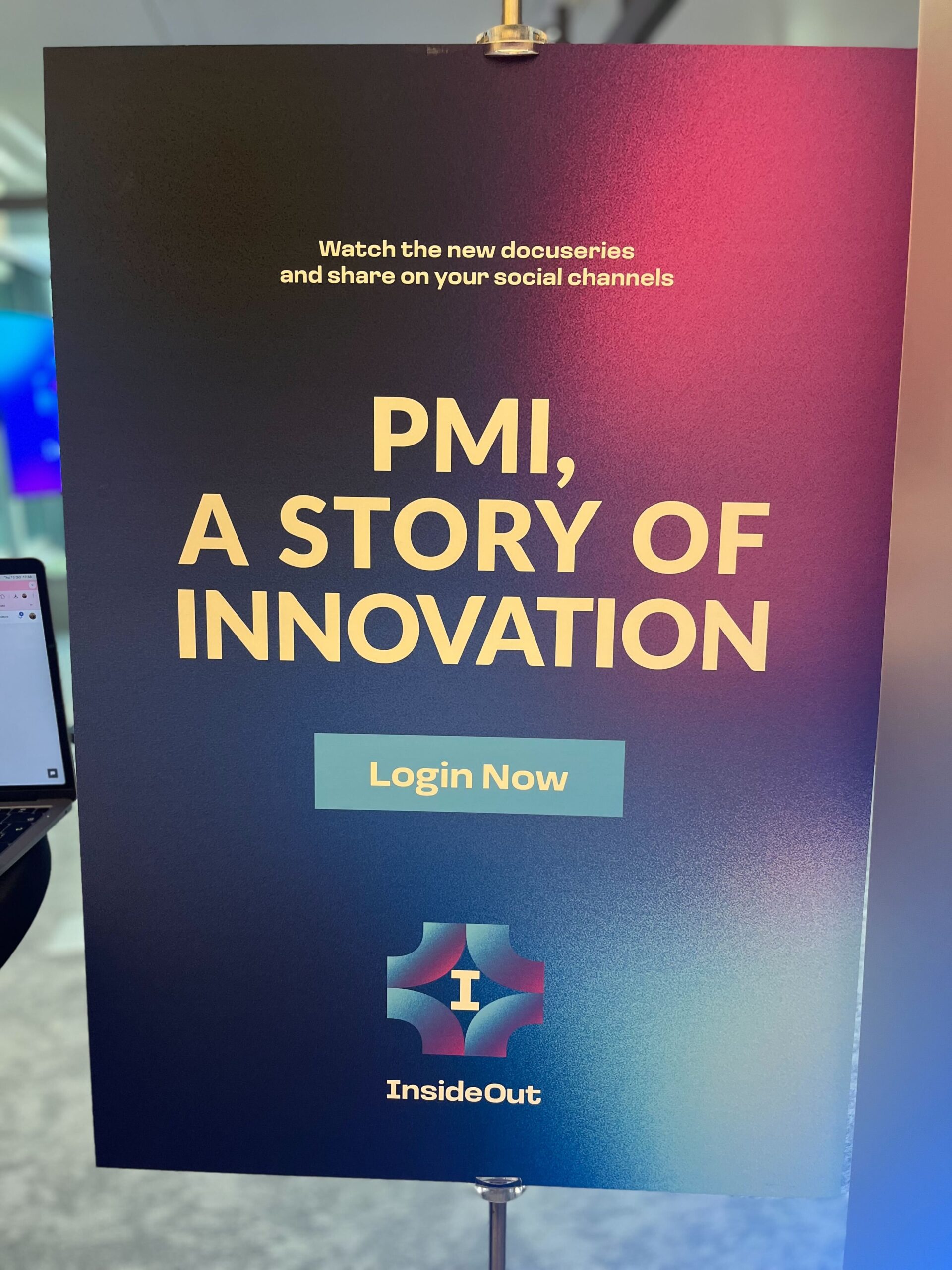

Tech Industry: Monthly Social Media Training for Upskilling
One of our tech clients holds a “social media school” for employees every month, empowering advocates to build confidence and skills.
This ongoing investment in educating their team on the benefits and best practices for social media led to one of their executives becoming a LinkedIn Top Voice. What a result! 👏
Notably, this client places a strong emphasis on delivering personalized content tailored to each employee advocate persona, whether in sales, tech, or the executive team. This is a key part of the strategy that helped the program’s interest snowball internally.
By leveraging AI to map these personas and customize content accordingly, they make personalization both efficient and easily scalable as the program expands.
Management Consulting: Linking DSMN8 Use with Company-Wide Campaign
During a major company milestone, one management consulting firm used its advocacy program to amplify a high-profile campaign and drive interest across the organization.
By aligning advocacy activity with this large-scale initiative, awareness spread quickly and participation grew organically.
As more employees shared and engaged with campaign content, the program gained momentum internally, resulting in stronger visibility and a unified sense of purpose throughout the business.
Top tip: To ensure participation, link performance metrics, such as OKRs and KPIs, to employee advocacy activities.
Real Estate: Interview Video with Senior Executives Highlighting the Benefits
A leading real estate firm produced an interview video featuring a senior executive discussing the benefits of their advocacy program.
Hearing firsthand how the program supports both business growth and employee engagement inspired wider participation throughout the company.
Top tip: Film a short video with your own senior leaders sharing their advocacy experiences and results. Leadership endorsement goes a long way in motivating employees to get involved!
Best Practices: Kickstarting Re-Engagement
That was a lot of information, so let’s summarize and cover best practices based on guidance from our experts and the successful examples they shared.
1. Make Employee Advocacy Part of Onboarding
Make sure that new employees are informed about the program. Otherwise, you risk it falling flat due to turnover.
Follow Nissan’s approach by making advocacy part of your official onboarding: within the first 60 days, every new Nissan employee is introduced to the program. This has created a flywheel of consistent program sign-ups, helping to sustain long-term participation.
2. Run Hands-On Training and Social Media Workshops.
Take inspiration from our tech client, who holds a monthly ‘social media school’. This empowers employees, helping them feel comfortable building their personal brands on social media while maximizing program results for you.
DSMN8’s customer success team is happy to support with this by hosting training sessions for your admins and advocates.
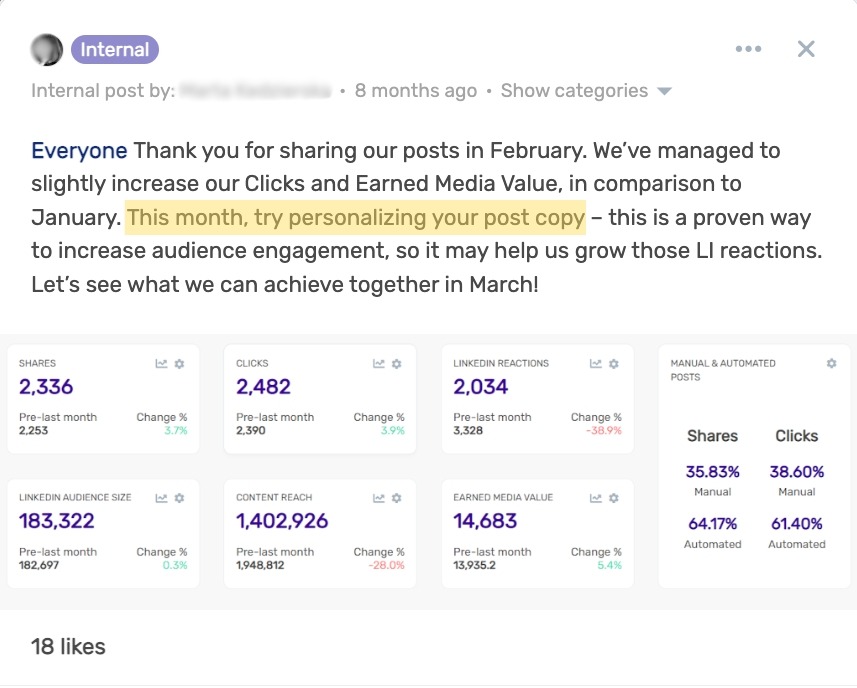
3. Leverage Internal Comms and Recognition
If your program is losing momentum, draw inspiration from our pharmaceutical client example. They revived engagement with a widespread internal campaign, using tools like gamification and sending regular newsletters that celebrated top advocates.
Recognizing individual and team achievements sparks healthy competition and new enthusiasm.
4. Make Your Advocacy Program Visible, Online and Offline
Make sure your advocacy program is clearly signposted in your internal comms tool or intranet. Better still, integrate DSMN8 with the tools your organization uses daily, from Slack or Teams to Salesforce.
Meeting employees where they are is the goal. To take this even further, draw inspiration from PMI and create posters or digital signage in your office with QR codes for instant platform access. Use a dynamic QR code generator to keep things flexible, allowing you to update the destination link anytime without reprinting materials.
Bonus tip: Ensure your marketing team can monitor leads and sales generated in Google Analytics by setting up UTM tracking.
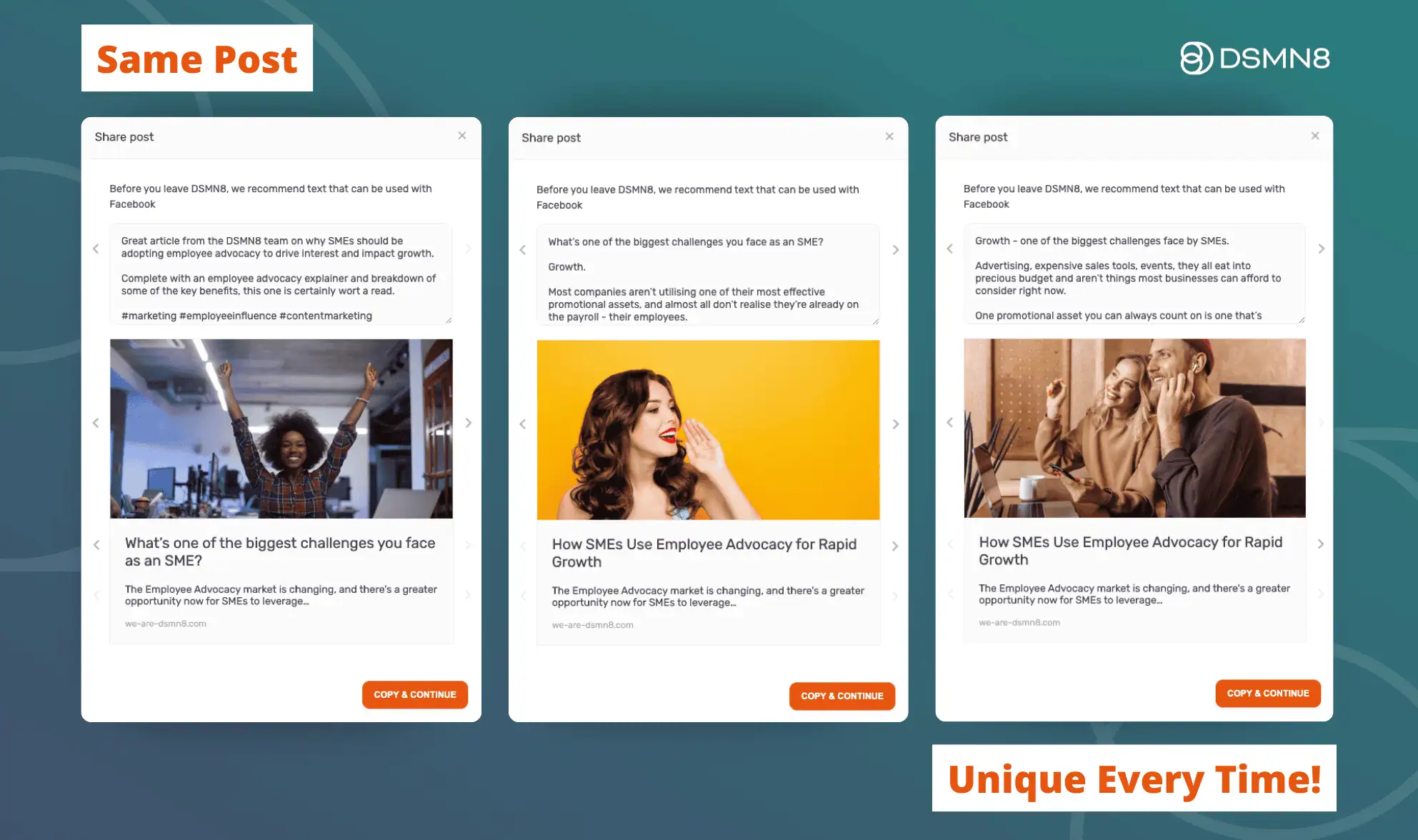
5. Tailored Content Always Wins
A clear takeaway from these success stories is the impact of tailored content.
Whether it’s Nissan creating dedicated micro-programs or a tech client leveraging AI to build detailed advocate personas, personalization consistently outperforms a one-size-fits-all approach.
6. Share Real Impact & Analytics
Sharing program analytics in your internal posts or newsletters allows employees to see the direct results of their efforts.
This transparency builds trust, reinforces the value of their contributions, and encourages ongoing participation.
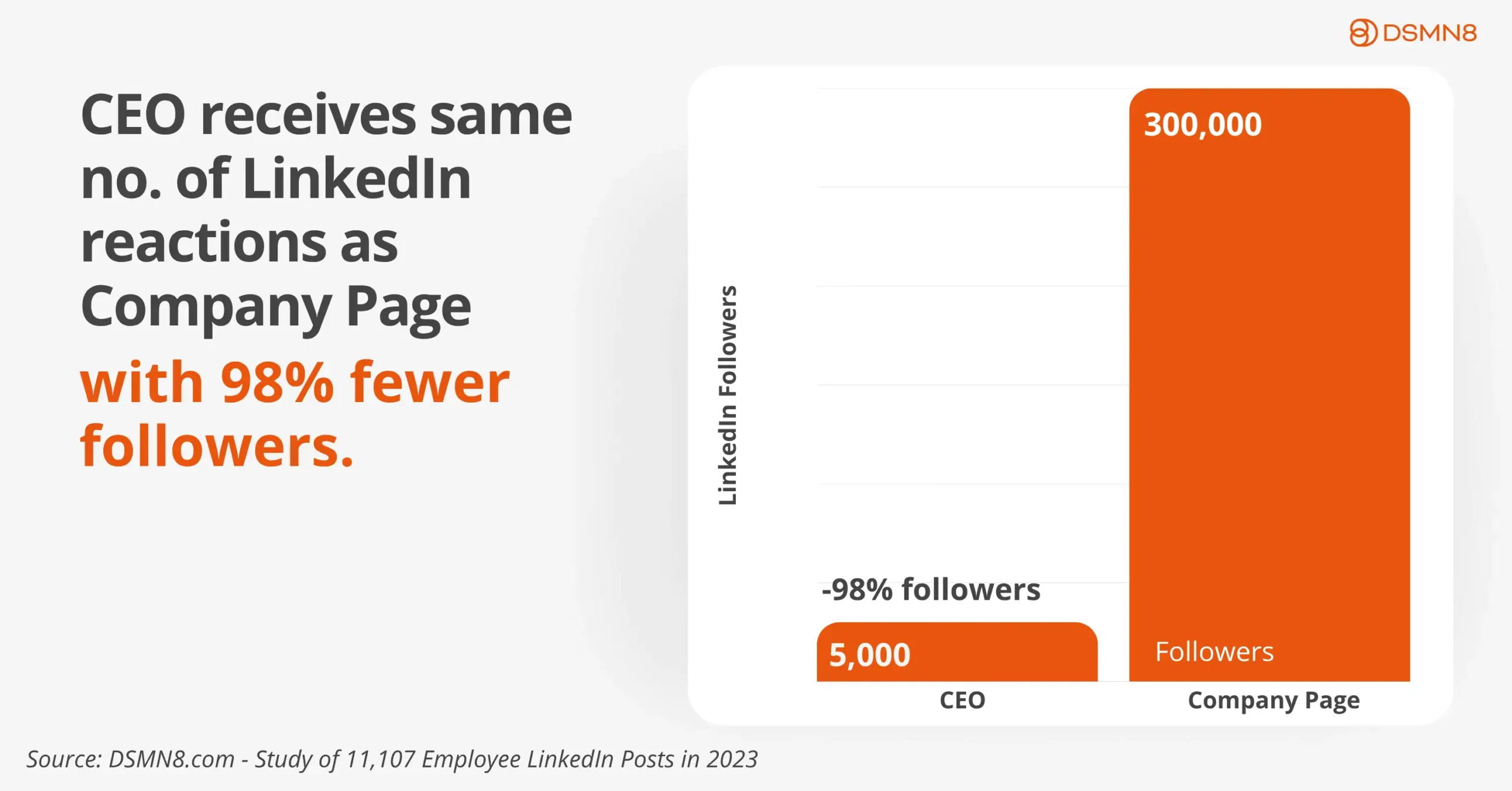
6. Leverage Leadership Support
If you only take away one thing from this article, let it be this: leadership support is a game-changer. When the CEO is involved, employees are much more likely to get on board, especially when leaders share updates and recognize top advocates.
Here’s the proof: In our analysis of 11,107 employee LinkedIn posts, a CEO from a civil engineering company achieved the same LinkedIn engagement as their company page, despite having just 5,000 followers compared to the company’s 300,000. When leaders participate, their impact is multiplied, and advocacy efforts gain real momentum.
Even indirect C-suite involvement, such as using our executive influencer tool, signals to the whole organization that employee advocacy truly matters.
Andy Lambert, Founder of ContentCal and Senior Management of Product at Adobe, says: “Success starts culturally and from the top. Leadership needs to lead by example; actively building their own presence and showing what ‘good’ looks like”. Check out his guest appearance on our podcast for more on what he calls Social 3.0.
Final Thoughts & Additional Resources
Reviving engagement in a mature employee advocacy program is entirely possible with the right mix of strategy, personalization, and communication.
By addressing common hurdles, leveraging platform features, and drawing inspiration from real-world success stories, program managers can foster lasting participation and stronger results.
Keep adapting, stay transparent, and continue celebrating your advocates. These small steps will help your program thrive for the long term!
More resources to help you sustain advocacy momentum:
- Employee Advocacy: 101 Cheat Codes by Bradley Keenan. With over 100 bite-sized tips, this one is essential for any program manager.
- Grab our Social Media Training Package, a bundle of helpful resources to support your advocates.
- Sign up for the Employee Advocacy Certification, a free course covering the ins and outs of employee advocacy.
- How To Be a Great Employee Advocacy Program Manager.
Emily Neal
SEO and Content Specialist at DSMN8. Emily has 10 years experience blogging, and is a pro at Pinterest Marketing, reaching 1 million monthly views. She’s all about empowering employees to grow their personal brands and become influencers.

